191. A 15-year-old boy is struck in the face by a baseball thrown by the opposing pitcher in a baseball game. The next day, he experiences difficulty smiling and is unable to blink his eye in response to irritation caused by a piece of dirt in the eye. Which of the cranial nerves shown in the illustration was most likely affected by this accident?
192. A 46-year-old man complains of pain affecting wide areas of his face and jaw. It is determined that the patient is suffering from a viral infection involving the peripheral aspect of a cranial nerve. Which of the cranial nerves shown in the illustration was most likely affected by the viral infection?
193. A 64-year-old man complains of difficulty in swallowing and decrease in salivation. On examination, the gag reflex cannot be elicited upon stroking the pharynx. Further examination reveals a tumor impinging upon a cranial nerve just beyond its exit from the brain. Which cranial nerve in the figure is most likely affected?
194. A 69-year-old woman begins to experience difficulty in extending her tongue. After a few days, she notes that when she tries to protrude her tongue, it deviates to the left. A diagnosis reveals the likely presence of a viral infection that specifically attacked a peripheral branch of one of her cranial nerves. Which cranial nerve in the figure is most likely affected?
195. Three weeks following a complaint by a 58-year-old man concerning hoarseness of voice and disturbances of the stomach, his situation rapidly worsens as indicated by loss of voice and further ulceration of the stomach. After being admitted to a local hospital, he soon dies of asphyxia. An autopsy reveals the presence of what appears to be a rapidly growing tumor that compressed a peripheral component of a cranial nerve. Which cranial nerve in the figure was affected by the tumor?
196. An 80-year-old woman displays marked rigidity of the lower limbs following a stroke. Which of the following brain regions is the most likely location of the stroke?
a. Posterior half of thalamus
b. Anterior hypothalamus
c. Dorsal half of midbrain
d. Dorsal half of pons
e. Ventral horn of spinal cord
197. A 37-year-old man suffers a massive brainstem stroke destroying much, if not all, of the midbrain and leaving the patient unconscious and unresponsive to sensory stimulation. He presents marked rigidity in his limbs. Which of the following pathways best accounts for the rigidity because its actions are now unopposed?
a. Rubrospinal tract
b. Lateral vestibulospinal tract
c. Corticospinal tract
d. Medial vestibulospinal tract
e. Lateral reticulospinal tract
198. A 43-year-old man, who was recovering from an infectious disease, experiences marked instability in his blood pressure, with episodes of spiking of blood pressure. After a series of extensive examinations, it is concluded that this disorder was due to the effects of the infectious agent upon a component of the peripheral nervous system. Which of the following constitute sites where an infectious agent could logically produce such an effect?
a. Superior ganglia of cranial nerves IX and X
b. Geniculate and trigeminal ganglia
c. Otic and superior salivatory ganglia
d. Carotid sinus and aortic arch
e. Carotid and aortic bodies
199. A 55-year-old woman is admitted to a local hospital for hypertension and is found to have a localized brainstem stroke resulting in partial baroreflex dysfunction, increased sympathetic activity, and paroxysmal hypertension. Which of the following is the most likely location of the stroke?
a. Trigeminal spinal nucleus
b. Fastigial nucleus
c. Midbrain reticular formation
d. Solitary nucleus
e. Autonomic nuclei of the facial nucleus (cranial nerve VII)
200. An individual experiences an ipsilateral paralysis of the soft palate and pharynx, resulting in hoarseness and dysphagia (inability to swallow) and, in addition, displays a loss of the carotid sinus reflex. Which of the following is most likely affected?
a. Cranial nerve XII
b. Cranial nerve XI
c. Cranial nerve X
d. Cranial nerve VII
e. Ventral horn cells of the cervical cord
201. In a patient who experiences hoarseness and dysphagia, it is concluded that he suffered from a lesion affecting selective brainstem neurons. Which of the following is most likely to be damaged in this case?
a. Solitary nucleus
b. Deep pontine nuclei
c. Nucleus ambiguus
d. Ventral horn cells of cervical cord
e. Inferior salivatory nuclei
202. In a patient who is unable to salivate or express the gag or uvular reflex, which of the following best characterizes the neurons associated with loss of these functions?
a. General somatic efferent and special visceral efferent
b. General visceral efferent and special visceral efferent
c. General somatic efferent and general visceral efferent
d. General visceral efferent and general visceral afferent
e. Special visceral efferent and special visceral afferent
203. A patient complains that he cannot move his right eye to the right and that the right side of his face is expressionless. Which of the following is the likely locus of the lesion?
a. Dorsal aspect of the medulla
b. Ventromedial medulla
c. Dorsal pons
d. Ventromedial pons
e. Medial midbrain
204. A 64-year-old woman is admitted to the emergency room after she experiences dizziness. Several days later, a neurological examination reveals that the patient is unable to move her right eye medially. Which of the following is the likely locus of the lesion?
a. Dorsal medulla
b. Ventromedial medulla
c. Dorsal pons
d. Ventromedial pons
e. Medial midbrain
205. A 72-year-old man experiences difficulty in walking downstairs and reports some double vision as well. Which of the following is the most likely locus of the lesion?
a. Medulla
b. Dorsal pons
c. Ventromedial pons
d. Midbrain
e. Spinal cord
206. An elderly man is admitted to the emergency room after experiencing double vision. Examination reveals the presence of pressure being exerted upon the wall of the cavernous sinus. When asked by the neurologist to follow the movement of his fingers when they are directed downward in a medial position, the patient is unable to do so with his right eye. Which of the following cranial nerves is affected in this patient?
a. Cranial nerve VIII
b. Cranial nerve VII
c. Cranial nerve VI
d. Cranial nerve IV
e. Cranial nerve III
207. A patient is admitted to the emergency room after having lost consciousness. Later, a neurological examination reveals loss of ability to move his right eye laterally when requested to do so. An MRI further reveals the presence of a brainstem infarction. Which of the following is the most likely locus of the infarction?
a. Ventromedial medulla
b. Ventrolateral medulla
c. Dorsolateral pons
d. Dorsomedial pons
e. Dorsomedial midbrain
208. An experiment is conducted to identify the primary groups of neurons in the central nervous system (CNS) that supply the inferior olivary nucleus. The experiment involves the placement of a recording microelectrode in the inferior olivary nucleus and the placement of stimulating electrodes in the neuronal groups that project to the inferior olivary nucleus. In which of the following sites should the investigator place his stimulating electrodes?
a. Hypothalamus and amygdala
b. Caudate nucleus and subthalamic nucleus
c. Solitary nucleus and nucleus of the ventrolateral medulla
d. Red nucleus and spinal cord
e. Deep pontine nuclei and vestibular nuclei
209. An investigator seeks to determine the primary neuronal target structure in the brain which receives inputs from the inferior olivary nucleus. In order to complete this study, the investigator microinjects a tracer substance into the inferior olivary nucleus, which is then transported from the cell bodies in the inferior olivary nucleus down the axons to their target structures. Which of the following structures would contain the tracer substance indicating that it constitutes a principal projection target of the inferior olivary nucleus?
a. Cerebral cortex
b. Midbrain periaqueductal gray
c. Vestibular nuclei
d. Dorsal column nuclei
e. Cerebellar cortex
210. An elderly female patient complains that she cannot taste the food she eats. A careful neurological examination reveals no evidence of peripheral damage of the taste receptors. The evidence suggests, instead, that there is selective damage to certain regions of the brainstem. Damage to which of the following sites would result in the selective loss of taste?
a. Superior olivary nucleus
b. Inferior salivatory nucleus
c. Solitary nucleus
d. Spinal nucleus of the trigeminal nerve
e. Reticular tegmental nucleus of the pons
Questions 211 to 213
Match each of the following vignettes with the labeled area of the brain with which it is most closely associated. Each lettered option may be used once, multiple times, or not at all.
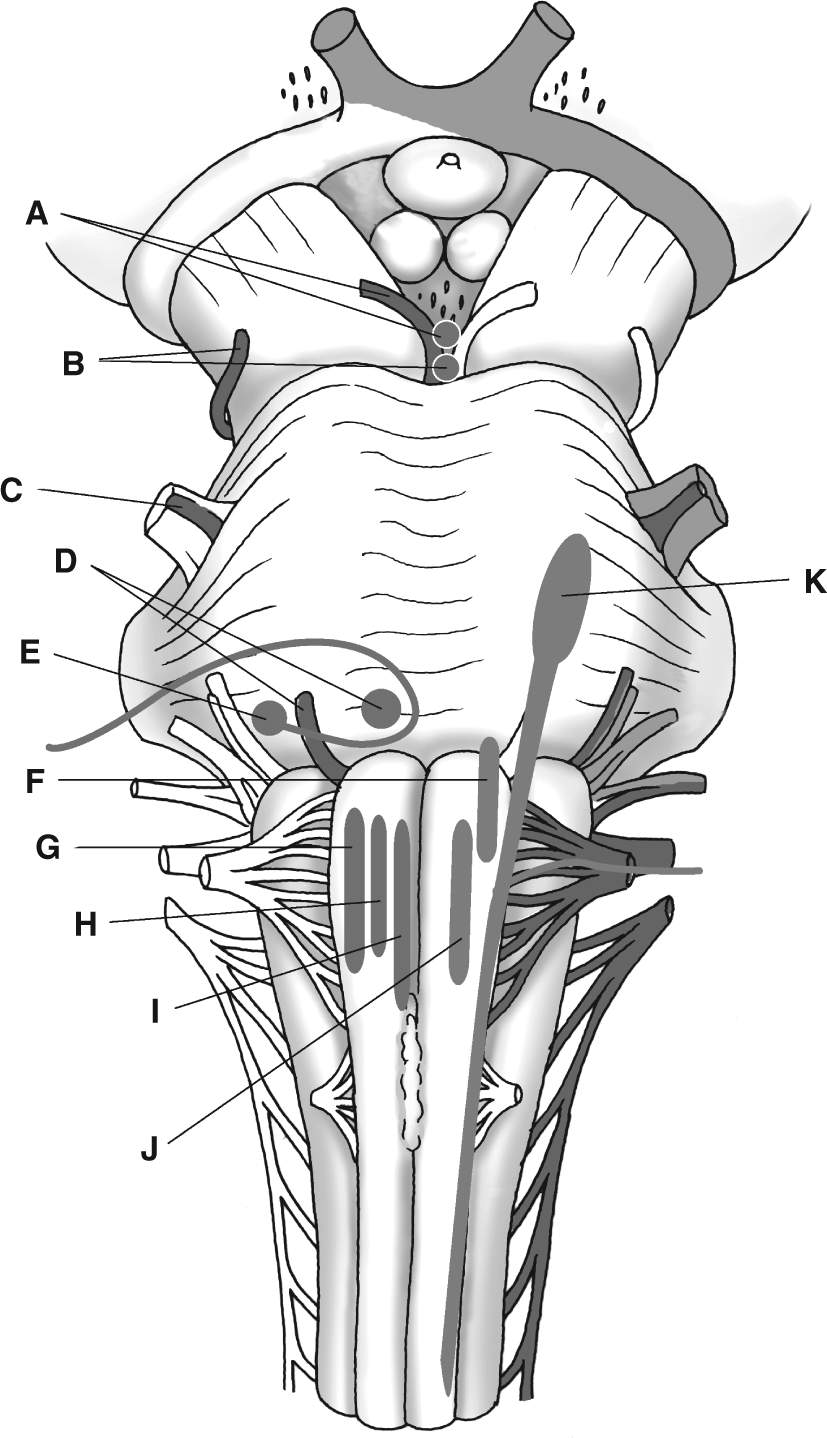
211. A 24-year-old man was hiking in the Rockies on a winter day and became lost. He is discovered a day later and is admitted to a local hospital for a precautionary examination. The patient suffers from overexposure to the cold and, when given a neurological test, has difficulty in closing his eyes, displays a loss of both the eye-blink reflex and increased sensitivity to sounds, and has difficulty displaying his teeth and chewing food, especially on the side of the mouth. In addition, his speech is somewhat slurred and he is unable to whistle upon request. Which of the cranial nerves shown in the diagram was affected by the cold in this individual?
212. As a result of a brainstem infarction, an elderly woman is unable to move her right eye to the right when following an object moving from left to right across her visual field. Which of the structures shown in the diagram is affected by this infarction?
213. Following a viral infection, a 64-year-old man has difficulty in biting down on food and the jaw is noted to deviate to one side. Which of the structures shown in the diagram has been affected by this infarction?
214. A 40-year-old man who suffers from a disorder of unknown origin complains to his physician that he has difficulty producing a smile on the left side of his face. Further analysis shows that the affected muscles are flaccid and the eyelids are open. Where do the cell bodies of origin within the CNS lie whose peripheral innervation of skeletal muscles are affected by this disorder?
a. Upper medulla
b. Lower pons
c. Upper pons
d. Lower midbrain
e. Upper midbrain
215. An elderly woman suffering from an infection complains that she cannot salivate and is unable to display lacrimation on the right side of her face. Following a neurological examination, it is determined that a peripheral component of a cranial nerve is affected by this disorder. Which of the following cell bodies of origin form the origin of the affected cranial nerve?
a. Dorsal motor nucleus of the vagus
b. Nucleus ambiguus
c. Inferior salivatory nucleus
d. Superior salivatory nucleus
e. Edinger-Westphal nucleus of cranial nerve III
216. A patient with a tumor reports that he is unable to experience the sense of taste from the anterior two-third of his tongue. Which of the following structures is most likely affected by the tumor?
a. Motor nucleus of the cranial nerve VII
b. Inferior and superior ganglia of cranial nerve IX
c. Cell bodies of the geniculate ganglion of cranial nerve VII
d. Nucleus ambiguus of inferior ganglion of cranial nerve IX
e. Dorsal motor nucleus of the cranial nerve X
Questions 217 to 221
Match each description with the appropriate site shown in the figure. Each lettered option may be used once, multiple times, or not at all.
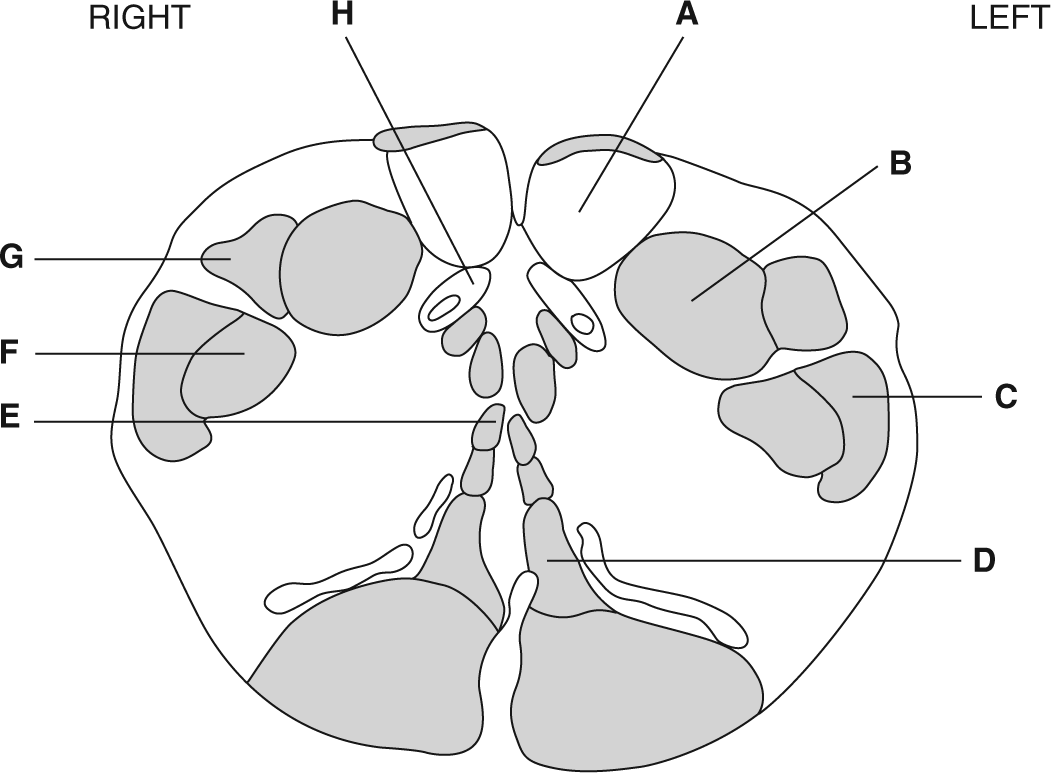
217. A middle-aged woman suffers a vascular occlusion involving part of the brainstem, resulting in selective loss of sensation in her left leg and concomitant ataxia. Which structure is most likely affected?
218. A 65-year-old man is admitted to the emergency room following a brief loss of consciousness. After he regains consciousness, he is examined by a neurologist who discovers that he has lost sensation in his left hand. Further analysis reveals that the loss of sensation was due to a vascular lesion. Which structure is associated with the loss of sensation in his hand?
219. A 47-year-old man is brought into the emergency room and is diagnosed with a small brainstem stroke. The patient presents with an inability to display reflex movements of the head in response to vestibular stimulation. Which structure is most likely affected by this lesion?
220. In order to alleviate excruciating pain in the face, a surgical lesion of the fiber bundle mediating pain sensation from the face is made. Which structure is associated with the surgical lesion?
221. A vascular lesion of the lower brainstem in a patient results in the loss of conscious proprioception in the limbs contralateral to the lesion. Which structure is affected by this lesion?
Questions 222 to 230
Match each description with the appropriate site shown in the figure. Each lettered option may be used once, multiple times, or not at all.
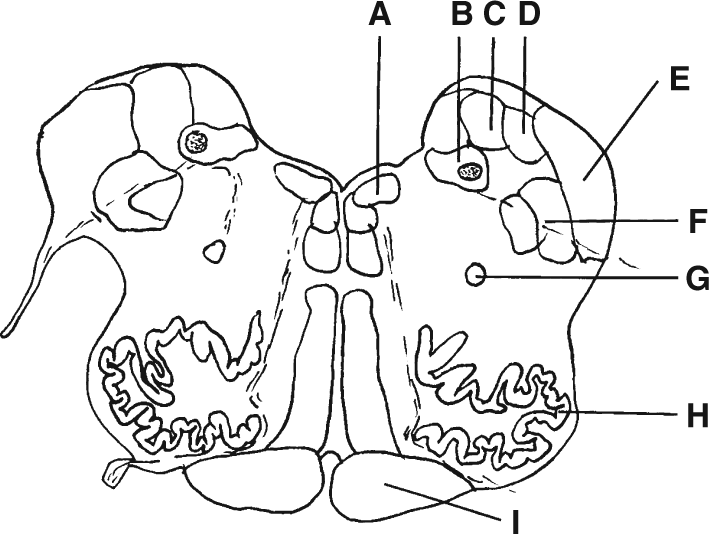
222. A young adult male suffers an injury to the region of the face that affects, in part, the peripheral nerve innervating the tongue. This results in some loss of ability to identify the taste of foods. Which structure in the brainstem would normally receive these peripheral taste inputs?
223. A stroke involving a part of the lower brainstem results in loss of the ability to coordinate movements of the head in response to changes in posture. Which structure is associated with this loss of function?
224. A midbrain stroke results in significant damage to the red nucleus, causing major degeneration of the descending fibers from this nucleus. Which structure present in the lower brainstem is now devoid of this input?
225. A 49-year-old man is admitted to the emergency room after he received a routine physical examination and was shown to have had a sudden increase in blood pressure. Further medical examination indicates that the patient suffered a limited occlusion of the brainstem. Which structure is likely affected, resulting in this change in blood pressure?
226. A patient who suffered a brainstem stroke was examined by a neurologist. He presents with ataxia and lack of coordinated movements. The neurologist concludes that the primary focus of the lesion affected the structure whose neurons contribute the largest number of fibers to the inferior cerebellar peduncle that supplies the cerebellum. Which structure is affected?
227. As a result of a stroke involving the lower brainstem, a 64-year-old man presents with an inability to swallow and loss of the gag reflex. Which structure is affected?
228. A 75-year-old man is found unconscious in his home and taken to the emergency room of a local hospital. When he recovers consciousness, he is unable to move his right arm or leg, and both limbs show spasticity. Which of the structures shown in the figure was damaged by the stroke?
229. Following a vascular lesion of the lower brainstem, a patient is tested for cranial nerve functions. When asked to stick out his tongue, it deviates to the side. Which structure is affected?
230. A 48-year-old man is suffering from intractable pain of the face and no drug therapy has been effective in alleviating the pain. At the suggestion of the consulting neurosurgeon, the neuronal pathway in the brainstem mediating pain sensation from the face region is surgically interrupted. Identify the structure in question on this figure.
Questions 231 to 236
Match each description with the appropriate site shown in the figure. Each lettered option may be used once, multiple times, or not at all.
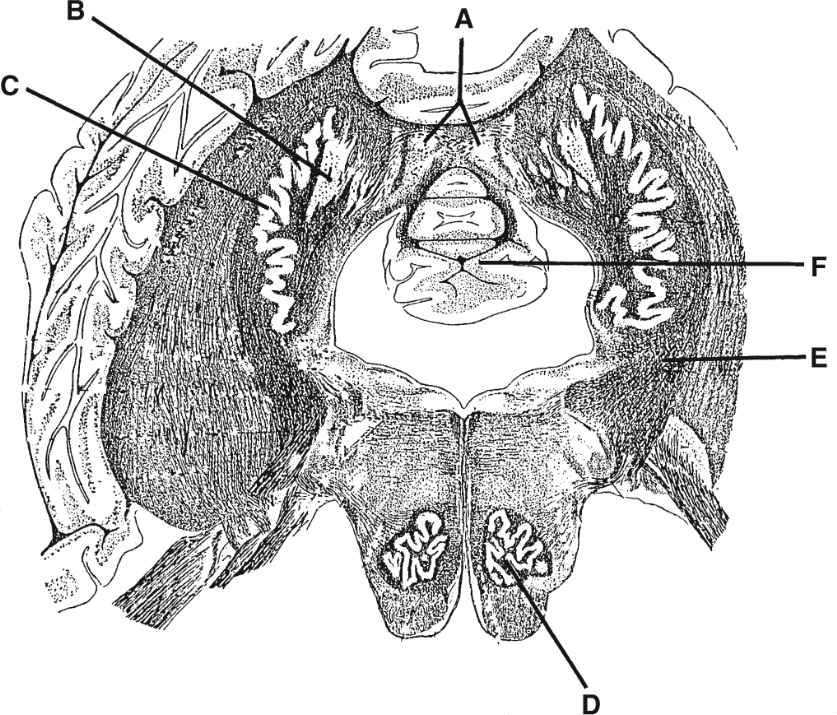
231. A 74-year-old woman who has been experiencing loss of balance is seen by a neurologist. During the neurological examination, the patient presents loss of balance, ataxia of movement, and irregularities in blood pressure (when measured several times over a period of about 90 minutes). An MRI suggests the presence of a vascular lesion in the region depicted in the diagram shown. Which structure, if damaged, would most likely result in this group of deficits?
232. An elderly woman is seen by a neurologist after she complains of loss of balance. Examination reveals the presence of ataxia of movement, nystagmus, and some erratic changes in blood pressure. The neurologist concludes that she is suffering from a vascular lesion that is limited to a single structure and that there is degeneration of axons that normally issue from this structure that supply the vestibular nuclei and reticular formation. Which of the structures shown in this diagram is affected by this lesion?
233. A middle-aged man was admitted to the hospital after having suffered a stroke. The patient presents with loss of ability to produce coordinated movements of the upper limbs with little loss of balance. Which is the most likely site of this lesion?
234. A 56-year-old man notices that when he tries to make purposeful movements, they appear to lack smoothness and are somewhat inaccurate. This trend tends to become progressively worse over time. After examining the patient, the neurologist concludes that the patient developed a small tumor at a structure whose axons normally supply the red nucleus but which are now disrupted by the tumor. A neurosurgeon is called to remove the tumor. In the diagram shown, which structure was removed?
235. A 73-year-old man displaying a wide, ataxic gait, is seen by a neurologist. The neurologist observes that the patient, in addition to displaying ataxia, also has nystagmus. An MRI reveals the presence of a tumor of the vermal region of the cerebellar cortex. Which structure shown in the diagram, which normally receives inputs from the vermal region of the cerebellar cortex, is now devoid of such inputs because of the tumor?
236. A 39-year-old man begins to have difficulties in coordinating simple movements such as opening a door or reaching for an object that he needed to access. After seeing a neurologist, he is given an MRI which reveals the presence of a large tumor impinging upon the lateral aspect of the cerebellar hemisphere. In the diagram shown, indicate the structure whose inputs are disrupted by the tumor.
Questions 237 to 243
Match each description with the appropriate site shown in the figure. Each lettered option may be used once, multiple times, or not at all.
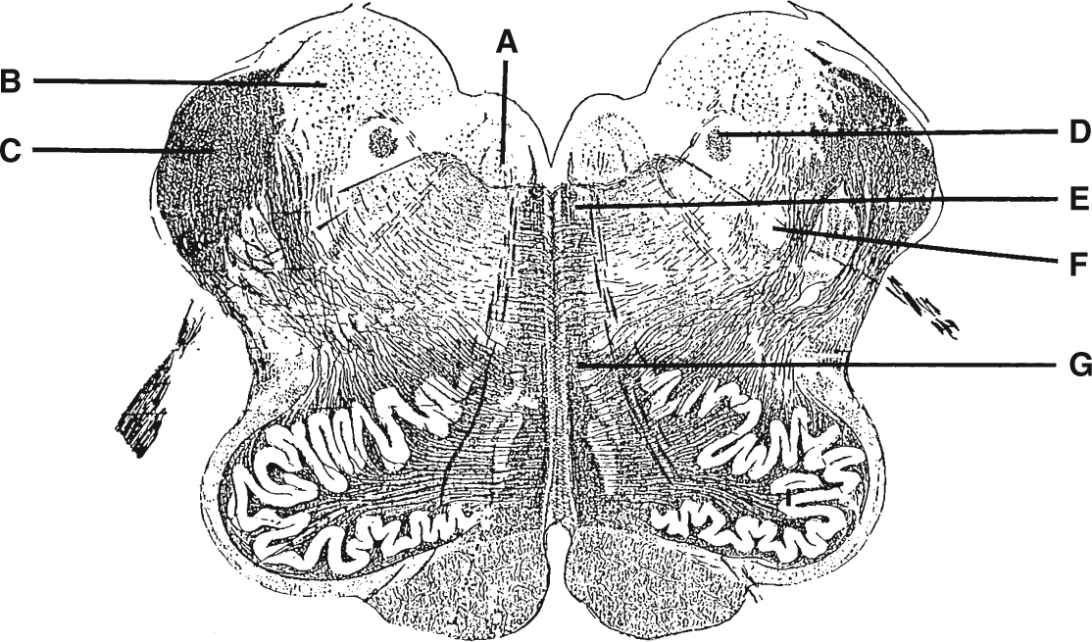
237. A person suffers a facial injury and subsequently experiences dizziness and some loss of balance. Which structure would lose inputs as a result of such an injury?
238. An individual suffers from a discrete brainstem lesion affecting the ascending and descending axons. The patient presents with loss of postural adjustment of the head in response to changes in the position of the body; there is also some nystagmus. Which structure is most likely affected by the lesion?
239. A patient complains that she has lost her sense of taste. A subsequent MRI suggests the presence of a small vascular lesion of the brainstem. Which structure is likely to be affected by this lesion?
240. When a patient attempts to protrude his tongue, it deviates to the side. Damage to which structure would account for this deficit?
241. Following a vascular lesion of the lower brainstem, a middle-aged woman is unable to feel the presence of a tuning fork placed on her leg or arm of one side of her body. On the affected side of her body, she is also unable to sense the position of her leg when asked to move it. Where is the lesion that would result in this deficit?
242. A patient presents with loss of pain sensation on one side of the face. It is discovered that it is probably due to a small brainstem lesion. Where is the likely locus of this lesion?
243. Following a lesion of a portion of the spinal cord, there is damage to the pathway conveying muscle spindle afferents to the cerebellum. Which of the structures shown in this diagram contains the axons that are now damaged as a result of lesion in the spinal cord?
Questions 244 to 248
Match each description with the appropriate site shown in the figure. Each lettered option may be used once, multiple times, or not at all.
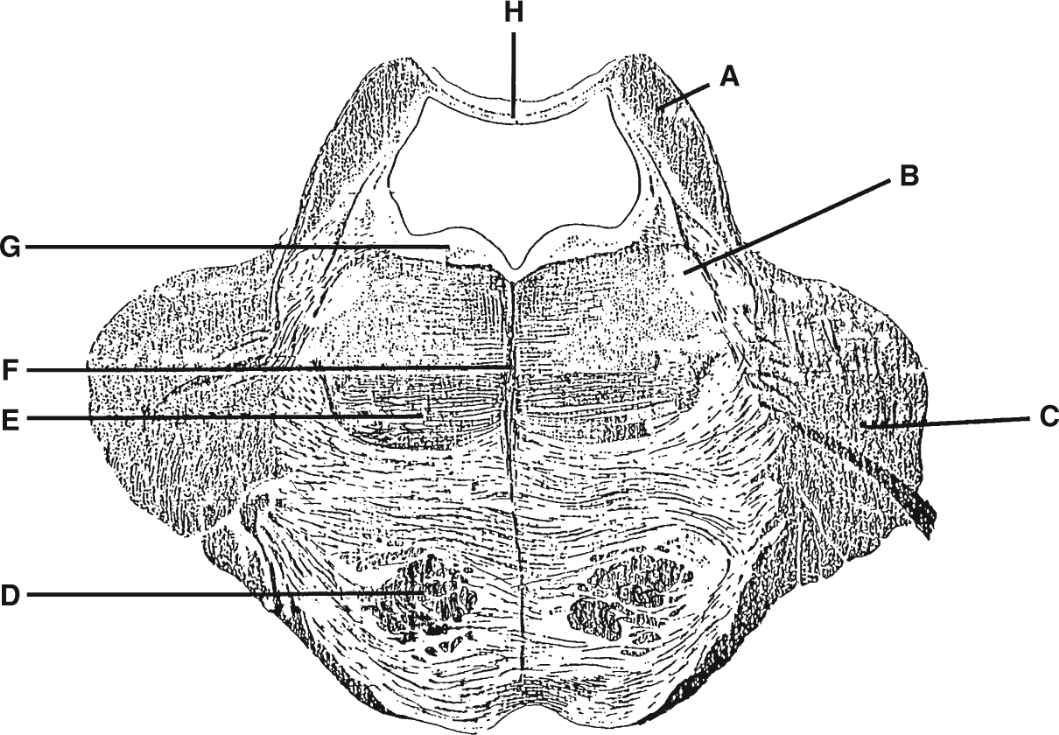
244. An individual suffers from a rare autoimmune disorder that destroys neuronal cell bodies situated in the basilar aspect of the pons. The patient presents with loss of coordination of movements of the upper limbs when attempting to make a purposeful response. Which fibers degenerated as a result of the autoimmune disorder?
245. A 63-year-old woman complains about having difficulties in chewing food. This problem has become progressively worse over time. A neurological examination and subsequent MRI reveals the presence of a discrete brainstem lesion that appears to be responsible for the disruption of the reflex mediating the chewing of food. In the figure shown, which is the most likely structure affected by the lesion?
246. An individual is admitted to a hospital after falling unconscious. Later, he presents with a UMN paralysis and is told that he had a stroke involving part of his brainstem. Damage to what structure would account for his deficit?
247. A 49-year-old man complains of loss of sensation along the arm, leg, and trunk of one side of the body. The patient undergoes an MRI, which detects the presence of a tumor restricted to a single structure at the level of the brainstem. Indicate the structure most directly affected by the tumor on the given diagram.
248. A person suffers from a degenerating disease that selectively destroys his deep cerebellar nuclei. The axons of which structure would most likely show significant degeneration as a result of this disorder?
Questions 249 to 253
Match each description with the appropriate site shown in the figure. Each lettered option may be used once, multiple times, or not at all.

249. An individual suffers a stroke involving part of his midbrain and, when tested by an audiologist, it is found that he has lost some ability in auditory discrimination, acuity, and ability to localize sound in space. The loss of which structure could possibly account for these deficits?
250. A person is admitted to a hospital after inhaling a toxic agent, which is later found to have produced significant cerebellar damage. The patient subsequently dies. An autopsy is performed, and brainstem sections are taken. The pathologist notes significant damage of a structure within the midbrain. Which structure would most likely show such a deficit?
251. A 79-year-old woman is admitted to the emergency room after suffering a stroke. The stroke involves parts of the cerebral cortex, resulting in a contralateral UMN paralysis. Which fibers would be degenerated?
252. A middle-aged man is admitted to the emergency room after falling downstairs. Later, he complains about having double vision and, during a neurological examination, is found to have difficulty moving his eye downward, especially when attempting to look medially. The neurologist concludes that the patient has a small vascular lesion of the brainstem. Which structure was most likely affected by the lesion?
253. An individual is diagnosed with a brainstem tumor after he presents with increased sensitivity to pain, reduction in blood pressure, and a general change and irregularity in emotionality. Which structure was most likely affected by the tumor?
Questions 254 to 258
Match each description with the appropriate site shown in the figure. Each lettered option may be used once, multiple times, or not at all.
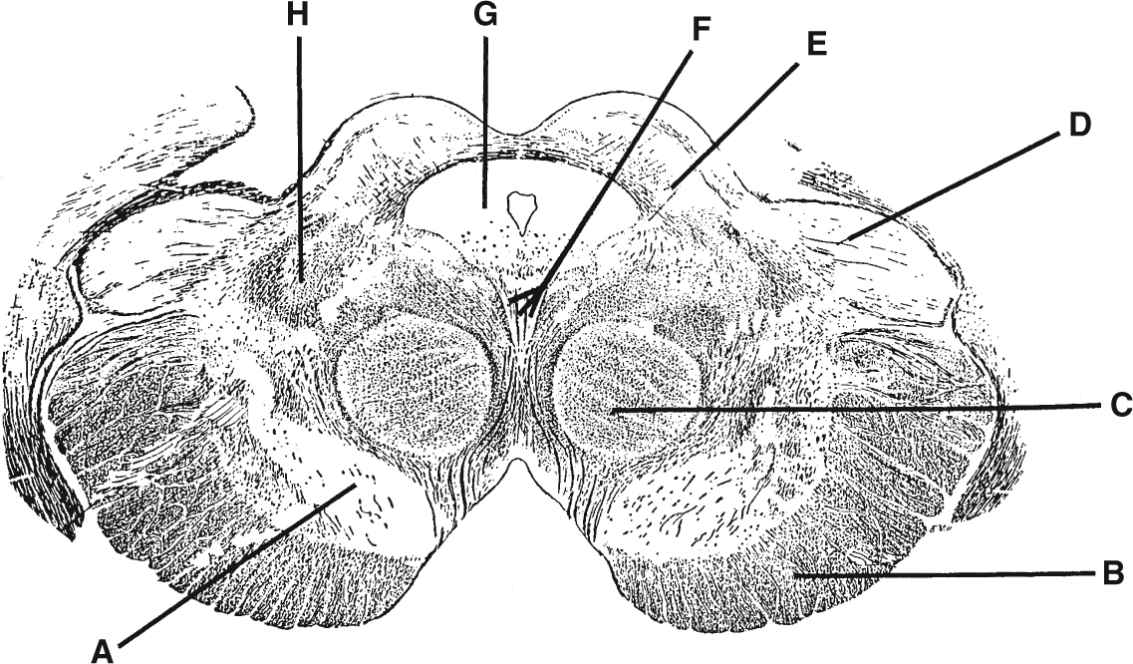
254. A patient is observed to have difficulty moving his eyes up and down, as well as in following moving objects. Subsequent diagnosis suggests that there is compression of part of the brainstem. Which was the principal structure most likely affected by this compression?
255. A 58-year-old woman is examined by an audiologist because she has difficulty in clearly hearing words. The examination reveals a reduction in auditory acuity, discrimination of sounds, and localization of sounds. The patient is referred to a neurologist and is given an MRI. The MRI indicates the presence of a localized tumor in the brainstem at the level indicated in the diagram shown. In this diagram, identify the structure that could account for this sensory loss?
256. A patient presents with motor dysfunctions characterized by rigidity, tremor, and akinesia. At which site could a lesion produce such a constellation of motor deficits?
257. A person presents with contralateral limb ataxia, together with a weakness of the medial rectus muscle and a fixed dilated pupil. The neurologist concludes that the patient sustained an infarction of the brainstem. Which structure constituted the principal focus of the infarction?
258. A 72-year-old woman has a rare autoimmune disorder that specifically destroys neuronal cell bodies affect. As a result, she is unable to direct her eyes medially or vertically, and her pupils do not constrict in response to light. Which structure was damaged by the disorder?
259. A 60-year-old man suffers from excruciating pain on the left side of his face. Since drug therapy is found to be ineffective in alleviating the pain, surgery is indicated. Which of the following structures should be surgically cut or destroyed in order to alleviate the pain?
a. First-order descending sensory fibers contained in the ipsilateral spinal tract of cranial nerve V
b. Neurons in the ventral posterolateral nucleus of the thalamus
c. Cells contained in the main sensory nucleus of the trigeminal nerve
d. Substantia gelatinosa
e. Midbrain periaqueductal gray
260. After eating a meal that contained spoiled food, a 15-year-old boy experiences an extensive bout of emesis. Which of the following structures most closely relates to this function?
a. Ventromedial hypothalamus
b. Posterior thalamus
c. Primary motor cortex
d. Dorsolateral pontine tegmentum
e. Area postrema
261. An individual experiences the following constellation of symptoms following a brainstem lesion associated with a stroke of that region: hoarseness, difficulty in swallowing, diminished gastric secretions, and loss of some cardiovascular reflex functions. To which of the following structures can these symptoms be attributed?
a. Cranial nerve VII
b. Cranial nerve IX
c. Cranial nerve X
d. Cranial nerve XI
e. Pontine reticular formation
262. After examining a patient, a neurologist concludes that he has suffered a stroke involving the dorsolateral medulla. Which of the following deficits did the neurologist see that allowed him to reach this conclusion?
a. Loss of pain and thermal sensation on the ipsilateral half of the face
b. Loss of pain and temperature sensation on the ipsilateral side of the body
c. Dysphonia
d. Hemiparesis
e. Intention tremor
263. An elderly woman is brought to see an audiologist after complaining about hearing difficulties. The audiologist notes that she is suffering from unilateral deafness and refers her to a neurologist for further examination. Damage to which of the following structures most likely accounts for her present condition?
a. The auditory cortex of one side
b. The lateral lemniscus of one side
c. Cranial nerve VIII on one side
d. The medial geniculate
e. The medial lemniscus
264. A middle-aged person is referred to a neurologist after experiencing certain visual deficits. Through the use of an MRI and other diagnostic procedures, it is concluded that there is some damage to a part of his nervous system. The patient presented with a lateral gaze paralysis, in which both eyes were conjugatively directed to the side opposite the lesion. In this condition, which of the following is the locus of the lesion?
a. Root fibers of cranial nerve III
b. Nucleus of cranial nerve III
c. Root fibers of cranial nerve VI
d. Nucleus of cranial nerve VI
e. Nucleus and root fibers of cranial nerve IV
265. An individual is referred to a neurologist because he is having difficulty moving his eyes horizontally to one side. The neurologist concludes that the individual has a vascular lesion. Which of the following structures was most likely affected by this lesion?
a. Paramedian pontine reticular formation
b. Ventrolateral medulla
c. Cranial nerve IV
d. Primary motor cortex
e. Ventral posterolateral nucleus of thalamus
266. A patient displays an ipsilateral paralysis of lateral gaze coupled with a contralateral hemiplegia. Which of the following is the most likely site of the lesion?
a. Ventromedial medulla
b. Dorsomedial medulla
c. Ventrocaudal pons
d. Dorsorostral pons
e. Ventromedial midbrain
267. A 15-year-old man is examined by a neurologist after complaining that he has a difficult time in appreciating the taste of food. It is discovered that he suffers from a rare genetic disorder that affects receptors that respond to changes in the chemical milieu of the environment. Which of the following sets of cranial nerves contain the special property of responding to changes in the chemical milieu?
a. Cranial nerves V, VII, and IX
b. Cranial nerves III, VII, and XII
c. Cranial nerves IX, X, and XI
d. Cranial nerves II, VII, and VIII
e. Cranial nerves I, VII, and IX
268. A patient displays the following constellation of symptoms: UMN paralysis of the left leg, paralysis of the lower half of the left side of the face, and a left homonymous hemianopsia. Which of the following regions most likely contains the lesion?
a. Medulla
b. Basilar pons
c. Pontine tegmentum
d. Midbrain
e. Forebrain
269. When a patient is asked to follow an object placed in the right side of his visual field, he is unable to move his right eye either up or down. Which of the following regions would most likely contain the lesion?
a. Medulla
b. Basilar aspect of the pons
c. Pontine tegmentum
d. Midbrain
e. Cerebellum
270. A patient is capable of displaying pupillary constriction during an accommodation reaction but not in response to a direct-light stimulus. Which of the following is the most likely site of the lesion?
a. Optic nerve
b. Ventral cell column of cranial nerve III
c. Pretectal area
d. Visual cortex
e. Edinger-Westphal nucleus of cranial nerve III
271. A person complains that he has a hard time sensing the taste of foods. A neurological examination reveals that he has a significantly diminished sense of taste. Which of the following groups of structures are the most likely sites where a lesion could logically lead to impaired sensation of taste?
a. Geniculate ganglion, chorda tympani, and medial lemniscus
b. Solitary nucleus, parabrachial nucleus, and ventral posteromedial nucleus
c. Solitary nucleus, ventral posterolateral nucleus, and postcentral gyrus
d. Solitary nucleus, ventral posteromedial nucleus, and superior parietal lobule
e. Geniculate ganglion and ventral posterolateral nucleus
Questions 272 and 273
272. A 79-year-old woman is found unconscious in her apartment and is taken to the emergency room of a local hospital. Upon regaining consciousness, the patient is examined by a neurologist, who finds loss of sensation on one side of her face, some difficulty in chewing, loss of pain and temperature on one side of the body, signs of Horner syndrome on one side of her face, some difficulty in hearing and localizing sound, and tremors and poor coordination in the movement of one of her arms. An MRI indicates the presence of a brainstem stroke. An occlusion of which of the following arteries would result in the lesion at A in the diagram shown here?

a. Basilar artery
b. Superior cerebellar artery
c. Anterior spinal artery
d. Vertebral artery
e. Posterior inferior cerebellar artery
273. An 84-year-old woman fainted while attending a family party and is immediately taken to the emergency room of a local hospital. When she regains consciousness, she presents with a UMN paralysis on one side of her body and weakness of muscles on the other side of her face. An occlusion of which of the following arteries would result in the lesion at B in the diagram shown in the previous question?
a. Paramedian branch of the basilar artery
b. Circumferential branch of the basilar artery
c. Superior cerebellar artery
d. Anterior inferior cerebellar artery
e. Anterior spinal artery
274. A 72-year-old man is seen by a neurologist after he complains of weakness in his facial muscle and hands, clumsiness, problems in articulating his speech, and difficulty in swallowing. An MRI reveals the presence of a vascular lesion in the brain. Which of the following regions most likely includes the site of the lesion?
a. Dorsomedial medulla
b. Ventromedial medulla
c. Basilar pons
d. Pontine tegmentum
e. Midbrain tegmentum
275. A 59-year-old woman presents with difficulty in chewing and ipsilateral sensory loss of much of her face. In addition, she also presents with a contralateral UMN hemiplegia. Further analysis reveals the presence of a vascular occlusion. Which of the following regions most likely includes the site of the lesion?
a. Rostral aspect of dorsomedial medulla
b. Ventral aspect of caudal medulla
c. Caudal aspect of basilar pons
d. Rostral aspect of basilar pons
e. Basilar aspect of caudal midbrain
Questions 276 to 278
276. A 34-year-old man is seen by an ophthalmologist after he complains about not being able to follow objects, such as the movement of cars along a road. He is referred to a neurologist, and a subsequent MRI reveals an arterial occlusion in the region shown at A in the figure. Identify the artery that supplies the region shown at A whose occlusion could account for this visual deficit.
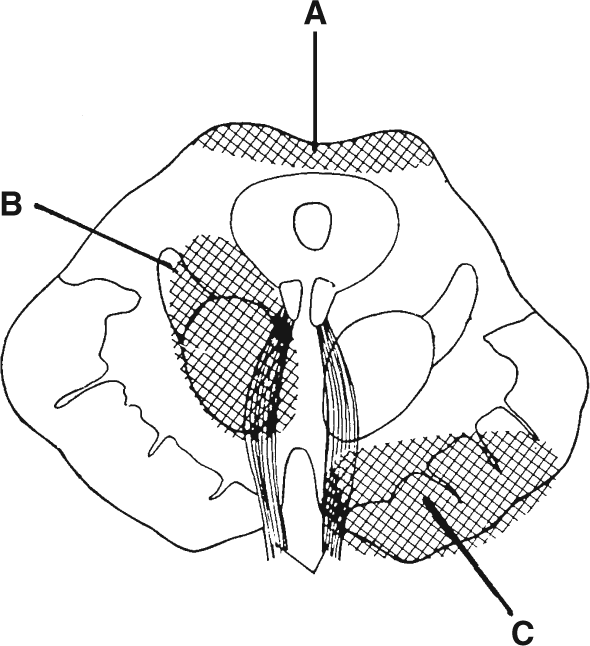
a. Posterior cerebral artery
b. Anterior spinal artery
c. Anterior cerebellar artery
d. Basilar artery
e. Posterior inferior cerebellar artery
277. A patient presents with loss of tactile sensation, pressure, and conscious proprioception as well as tremor and some loss of coordination in the limb on the same side. A subsequent MRI reveals that there is a localized tumor present in the region indicated by B in the figure. Which of the following structures are likely affected by this tumor that could account for these deficits?
a. Red nucleus and medial lemniscus
b. Red nucleus and raphe nucleus
c. Superior cerebellar peduncle and substantia nigra
d. Reticular formation and oculomotor nerve
e. Lateral lemniscus and trochlear nerve
278. A patient presents with an ipsilateral paralysis involving an inability to move his eye vertically, and the affected eye is also abducted. The patient also has a UMN paralysis that includes part of the face. The lesion, determined from an MRI, is depicted at C in the diagram. Which of the following structures are affected by this lesion?
a. Substantia nigra and crus cerebri
b. Red nucleus and crus cerebri
c. Crus cerebri and cranial nerve III
d. Red nucleus and substantia nigra
e. Substantia nigra and cranial nerve III
279. A newborn suffers from a congenital error in development in which the neurons in the ventral aspect of the midbrain, which includes the sub-stantia nigra and ventral tegmental area, fail to form. This developmental abnormality impacts significantly upon the neurochemistry and functions that relate to other regions of the brain. Which of the following statements best describes the results of such an error in development?
a. There is extensive loss of noradrenergic input in the limbic system, basal ganglia, and cerebral cortex.
b. There is loss of peptidergic input in the limbic system and hypothalamus.
c. There is loss of serotonergic input in the basal ganglia and hypothalamus.
d. There is extensive loss of GABAergic input to the limbic system, basal ganglia, and cerebral cortex.
e. There is extensive loss of dopaminergic input to the basal ganglia, limbic system, and cerebral cortex.
280. A 60-year-old man suffers an upper pontine stroke that selectively damages neuronal pathways mediating auditory signals from the lower brainstem to other relay neurons in higher levels of the brainstem. Which of the following is the principal ascending auditory pathway of the brain-stem affected by the stroke?
a. Medial lemniscus
b. Lateral lemniscus
c. Trapezoid body
d. Trigeminal lemniscus
e. Brachium of the superior colliculus
Questions 281 and 282
281. A 64-year-old woman has had heart disease for many years. While carrying chemicals down the stairs of the dry-cleaning shop where she works, she suddenly loses control of her right leg and arm. She falls down the stairs and is able to stand up with some assistance from a coworker. When attempting to walk on her own, she has a very unsteady gait, with a tendency to fall to the right side. Her supervisor asks her if she is all right, and notices that her speech is very slurred when she tries to answer. He calls an ambulance to take her to the nearest hospital. Upon admission, her face appears symmetric, but when asked to protrude her tongue, it deviates toward the left. She is unable to tell if her right toe is moved up or down by the physician when she closes her eyes, and she cannot feel the buzz of a tuning fork on her right arm and leg. In addition, her right arm and leg are markedly weak. The physician can find no other abnormalities in the remainder of the patient’s general medical examination. Where in the nervous system did the damage occur?
a. Right lateral medulla
b. Occipital lobe
c. Left lateral medulla
d. Right cervical spinal cord
e. Left medial medulla
282. In the patient in Question 281, where in the nervous system could a lesion occur that would cause arm and leg weakness but spare the face?
a. Right corticospinal tract in the cervical spinal cord
b. Left inferior frontal lobe
c. Right medullary pyramids
d. Occipital lobe
e. Right side of basilar pons
283. A 65-year-old man with a history of heart disease is admitted to the emergency room after being found unconscious in his home. When the patient regains consciousness and is examined by a neurologist, it is discovered that he cannot identify the presence of a tuning fork, pencil, or pressure applied to his left leg. In addition, he is unable to move his left leg or arm. Other clinical signs are not apparent. Which of the following regions most likely accounts for the deficits described?
a. Ventromedial aspect of medulla-spinal cord border
b. Rostral aspect of the ventromedial medulla
c. Dorsolateral aspect of the caudal aspect of medulla
d. Dorsomedial aspect of the pontine tegmentum
e. Dorsomedial aspect of the midbrain tegmentum
284. A patient displays a deviation of the tongue to the left and a hemiparesis on the right side. The lesion is located in which of the following regions?
a. Right hypoglossal nucleus
b. Left hypoglossal nucleus
c. Right inferior frontal lobe
d. Right ventromedial medulla
e. Left ventromedial medulla
285. A patient is suffering from a speech deficit, coupled with an ipsilateral loss of pain and temperature on the left side of the face and a contralateral loss of pain and temperature from the body, as well as some autonomic dysfunctions. The physician who is called to see the patient in the emergency room notes that his speech is slurred as if he were intoxicated, though the grammar and meaning were intact. Which of the following types of speech deficit did the patient have?
a. Broca aphasia
b. Wernicke aphasia
c. Mixed aphasia
d. Dysarthria
e. Agnosia
Questions 286 and 287
Stay updated, free articles. Join our Telegram channel

Full access? Get Clinical Tree







